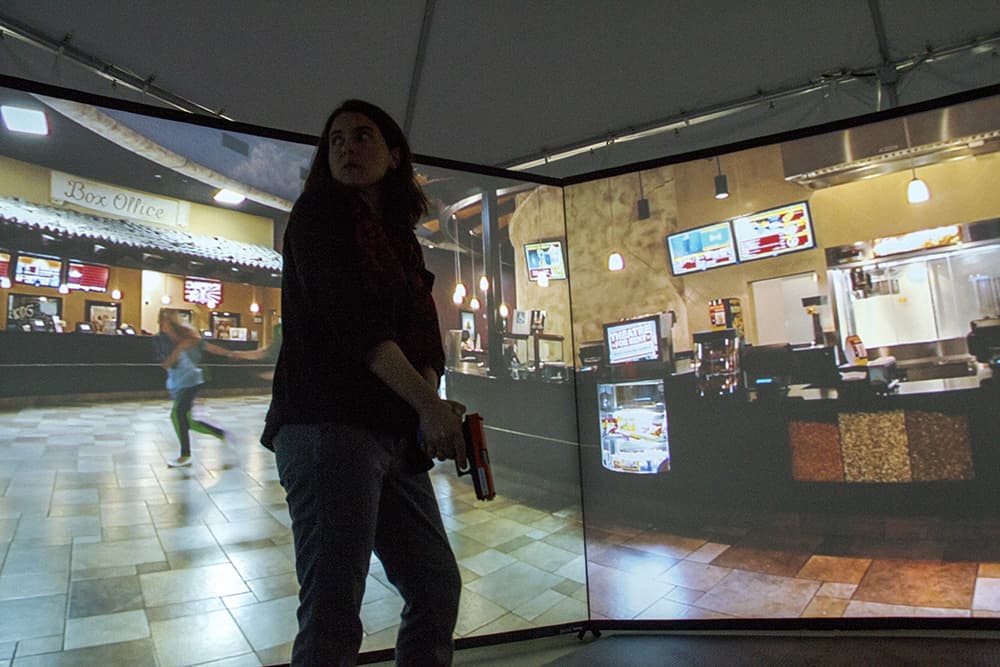
The good news is that I saved a baby. The bad news is that I shot a police officer.
This was all virtual, of course, my good decision-making and my bad playing out inside a giant tent filled by a wraparound screen that took me to a roadside where a suicidal man threatened to kill himself and his infant daughter and to a movie theater where two men had shot multiple people.
This machine, the VirTra V-300, cost $283,389 and was paid for with a $100,000 grant from WellsFargo and money from the Denver Police Foundation, the non-profit that supports the department.
It can play some 100 scenarios, with an instructor changing what happens inside the scenario in response to officers' actions. A suspect can lay down his weapon if an officer talks him down or get agitated and shoot if he feels trapped.
Officers wear a small shock device that gives a jolt if they get hit.
Unlike previous simulators the department used, it allows groups of officers to train together. They have to watch out for each other and work together. They can see how the group dynamic affects their choices. They can also practice not engaging in "sympathetic trigger pull," the phenomenon of shooting because someone else started shooting.
Denver police plan to take footage from real places around the city like the 16th Street Mall and Mile High Stadium and create scenarios that could play out there.
Denver police invited the media to experience these simulations on Friday as the debate over police use of force rages nationally. In the most recent incident, police in El Cajon, California, shot and killed a man Tuesday after his sister called to say he was acting strangely. Video of the shooting shows Alfred Olango raising his hands rapidly toward an officer in what police called a "shooting stance." The object he pulled from his pocket turned out to be an electronic cigarette.
The reporters are not the first civilians to try out the simulator. Some folks who have been critical of the police have been invited through as well. I asked Lt. John Coppedge of the training bureau if one purpose is to get people to be less critical by realizing, hey, in this situation, I might shoot too.
He pauses. He would like people to be more understanding of the challenges. The experience creates more room for dialogue, he said.
As they prepare the demonstration, I hear Chief Robert White tell Training Division Cmdr. Rick Kyle to make sure we get a de-escalation scenario "so they don't think it's all about shooting."

The first scenario has us driving down a semi-rural road when a distraught woman flags us down and says her husband has taken their baby and he's acting very strangely. We find him a short time later, holding the baby wrapped in a blanket, standing at the side of a bridge, screaming that he's going to kill himself and kill the baby too.
Police respond to a LOT of mental health crises. For the most part, we have no one else to send. People having mental health problems might be less compliant and more erratic in their behavior; it comes with the territory. By some estimates, a quarter of all people killed by police have mental health problems. One estimate said half of all people killed by police have a disability -- a psychological issue, a brain injury, an intellectual disability.
Sometimes people in mental health crisis become a danger to others, like this father threatening to throw the baby off the bridge. I'm intensely aware of how useless the gun is in this particular set of circumstances. If I were to shoot him, he would drop the baby.
The other reporter in there with me keeps his gun trained on the man. The instructor later asks him why. Because he had the gun and thought that was what he was supposed to do and then didn't know how to stop doing it.
Coppedge tells me later that in 24 years of policing, he's learned that his best weapon is his mouth. And so it is in this scenario.
It ends well, with the baby laid gently on the ground and the man surrendering as well.
The next scenario has us responding to a movie theater. The initial call has to do with suspicious men in camouflage, but as we arrive, people are running out screaming and we can hear shots. It's one thing going wrong after another. There's a screaming man who has a hostage at gunpoint. Am I supposed to de-escalate or bark orders? He shoots her, and we shoot him.
Now I feel like I need to be quicker to act. "Look behind you," the instructor says. There's a man with a gun. I shoot. It's another officer.
One of the criticisms of these types of simulators is that they turn the life and death decisions officers make on the streets into a video game, where the consequences aren't as real. I didn't feel that way in the first scenario, but as the second one goes on, that feeling creeps in. Maybe that's because mass shooters essentially are playing a video game with real lives, and they force us all to play as well.
I'm also very aware that I have no idea what I'm doing. I keep wishing someone would just give me some instructions. Tell me what to do, and I'll do it.
We encounter the second gunman again in the parking lot and shoot him, but not before he shoots at us. I'm not sure if we're hit, but I think we probably are.
Police officials said the VirTra V-300 is one piece of a larger shift in how officers are trained that goes back a couple years now.
"By increasing the amount of experiential training, we hope to develop and we will develop critical thinkers who are better equipped to make split-second decisions in rapidly evolving situations," Kyle, the training commander, said.
Sgt. Eric Knutson called the VirTra V-300 a "stress inoculation" that helps officers adjust to and manage the adrenaline dumps that occur in high stakes encounters.
"They're able to recognize when they're getting tunnel vision and open things up," he said. "They're more comfortable, they're able to think better. We're actually wanting to teach them, if we have the opportunity, to ask questions, slow things down and start getting a dialogue."
Assistant Editor Erica Meltzer can be reached via email at [email protected] or twitter.com/meltzere.
Subscribe to Denverite’s newsletter here.












